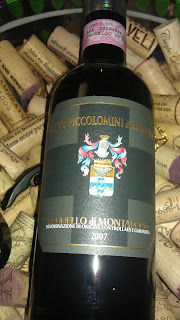I recently ran across a Cellartracker tasting note mentioning freezing opened wine for later consumption. Intrigued,
I posted a note on Wineberserkers.com getting several interesting responses and decided to give it a try.
A quick Google search reveals several
sources of information regarding the
trial and error and the
science of freezing wine. Basically, at common household freezer temperatures the water component of the wine will freeze leaving traces of unfrozen liquid with highly concentrated alcohol. In the short-term the wine remains largely uncompromised, although you might see some sediment from
tartaric acid falling out of solution.
In unopened bottles the expansion of the freezing liquid and ultra-low humidity can push out or dry out corks or even crack the glass, so there doesn't really seem to be a practical application for freezing wine unopened. As for storing an opened bottle for later consumption, what I read considered this viable although there were varying opinions on the length of time you would want to leave the wine frozen (or how much the structure might be affected).
I opened a bottle of
Melville 2008 Pinot Noir Terraces, Sta. Rita Hills. Out of the bottle and over several hours the wine was showing a full bouquet and drinking with ample bold red fruit along with big spice notes, hints of earth, and richly textured integrated structure, along with some heat on the finish.
 |
| Straight from the freezer |
With just under half a bottle remaining, I decanted the wine into a 375 ml bottle that I use for storage and placed it diagonally in my freezer. Upon removing the bottle the following day, the mostly frozen wine remained diagonally suspended. I left the bottle on my counter until the liquid leveled out, then placed it in lukewarm water in my sink to finish thawing. After about an hour the wine was at a good approximate 60 degree temperature for drinking Pinot Noir.
In drinking the previously frozen Melville Terraces, whatever affects freezing a wine may have over 24 hours may have were imperceptible to me. I might have said that the structure of the wine had softened ever-so-slightly, but I couldn't be certain. The flavor profile was identical to me, and there was no oxidation. Basically as far as I could reasonably tell I was drinking an identical glass of wine to the one I had decanted 24 hours earlier. Next time I'll try the freezing for a longer time frame.
With mixed results I've pumped, gassed, and dropped little plastic disks into my wine bottles. The only question that remains for me is why this isn't the consensus for saving an opened bottle.









